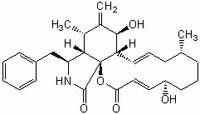250233 Sigma-AldrichCytochalasin B, Helminthosporium dematioideum - CAS 14930-96-2 - Calbiochem
Cytochalasin B, Helminthosporium dematioideum - CAS 14930-96-2, is a cell-permeable fungal toxin that inhibits cytoplasmic division by blocking the formation of contractile microfilaments.
More>> Cytochalasin B, Helminthosporium dematioideum - CAS 14930-96-2, is a cell-permeable fungal toxin that inhibits cytoplasmic division by blocking the formation of contractile microfilaments. Less<<MSDS (material safety data sheet) or SDS, CoA and CoQ, dossiers, brochures and other available documents.
Recommended Products
概述
| Replacement Information |
|---|
重要规格表
| CAS # | Empirical Formula |
|---|---|
| 14930-96-2 | C₂₉H₃₇NO₅ |
价格及供货情况
| 产品目录编号 | 库存情况 | 包装 | 数量 / 包装 | 价格 | 数量 | |
|---|---|---|---|---|---|---|
| 250233-5MGCN |
|
铝滚桶 | 5 mg |
|
— |
| Product Information | |
|---|---|
| CAS number | 14930-96-2 |
| ATP Competitive | N |
| Form | White solid |
| Hill Formula | C₂₉H₃₇NO₅ |
| Chemical formula | C₂₉H₃₇NO₅ |
| Reversible | N |
| Structure formula Image | |
| Quality Level | MQ100 |
| Biological Information | |
|---|---|
| Primary Target | Blocking the formation of contractile microfilaments |
| Purity | ≥98% by HPLC |
| Physicochemical Information | |
|---|---|
| Cell permeable | Y |
| Dimensions |
|---|
| Materials Information |
|---|
| Toxicological Information |
|---|
| Safety Information according to GHS | |
|---|---|
| RTECS | RO0205000 |
| Product Usage Statements |
|---|
| Packaging Information |
|---|
| Transport Information |
|---|
| Supplemental Information |
|---|
| Specifications |
|---|
| Global Trade Item Number | |
|---|---|
| 产品目录编号 | GTIN |
| 250233-5MGCN | 04055977199147 |
Documentation
Cytochalasin B, Helminthosporium dematioideum - CAS 14930-96-2 - Calbiochem MSDS
| 职位 |
|---|
Cytochalasin B, Helminthosporium dematioideum - CAS 14930-96-2 - Calbiochem 分析证书
| 标题 | 批号 |
|---|---|
| 250233 |
参考
| 参考信息概述 |
|---|
| Tanaka, Y., et al. 1994. Exp. Cell Res. 213, 242. Theodoropoulos, P.A., et al. 1994. Biochem. Pharmacol. 47, 1875. Benya, P.D., and Padilla, S.R. 1993. Exp. Cell Res. 204, 268. Cairns, M.T., et al. 1991. J. Biol. Chem. 266, 8176. Nowak, D. 1990. Biomed. Biochim. Acta 49, 353. Wang, F., et al. 1990. Biochem. Biophys. Res. Commun. 171, 543. Edwards, S.W., and Lloyd, D. 1988. FEBS Lett. 227, 39. |







